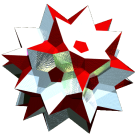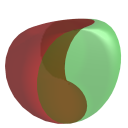|
Acronym
|
...
|
|
Name
|
dual of uniform triangular prism,
triangular dipyramid (but not tridpy),
o3m3o3o cell
|
|
|
 © ©
|
|
Inradius
|
1/sqrt(21) = 0.218218
|
|
Vertex figure
|
[T3], [t4]
|
|
Dihedral angles
|
- at long edge: arccos(-1/7) = 98.213211°
- at short edge: arccos(-1/7) = 98.213211°
|
|
Dual
|
trip
|
|
Face vector
|
5, 9, 6
|
|
Confer
|
- more general:
-
m mNo
- related Johnson solids:
-
tridpy
- variations:
-
co oo3ox&#zy (c = sqrt(8)/3, y = sqrt(5)/3, ico derived)
co oo3ox&#zy (c = sqrt(2)/3, y = sqrt(7/18), tes derived)
co oo3ox&#zy (c = (sqrt(5)-1)/3, y = sqrt[(9-sqrt(5))/18, hi derived)
- general polytopal classes:
-
Catalan polyhedra
|
External
links
|




|
The triangles {(t,t,T)} have vertex angles t = arccos(3/4) = 41.409622° resp. T = arccos(-1/8) = 97.180756°.
Note that the term dipyramid, although stated above, in general says nothing about the relative ratio of the to be chosen lacing edge size.
There is an equilateral dipyramid as well, tridpy (n=3).
– Whereas in here the edge ratio is chosen such as to match its
duality to the trip!
The a edge, provided in the below description, only qualifies as pseudo edge wrt. the full polyhedron.
In fact it rather describes its tip-to-tip distance.
Incidence matrix according to Dynkin symbol
m m3o =
oxo3ooo&#yt → both heights = a/2 = 1/3
y = 2/3
(pt || pseudo {3} || pt)
o..3o.. | 1 * * | 3 0 0 | 3 0 [T3]
.o.3.o. | * 3 * | 1 2 1 | 2 2 [t4]
..o3..o | * * 1 | 0 0 3 | 0 3 [T3]
-----------+-------+-------+----
oo.3oo.&#y | 1 1 0 | 3 * * | 2 0 y
.x. ... | 0 2 0 | * 3 * | 1 1 x
.oo3.oo&#y | 0 1 1 | * * 3 | 0 2 y
-----------+-------+-------+----
ox. ...&#y | 1 2 0 | 2 1 0 | 3 * {(t,t,T)}
.xo ...&#y | 0 2 1 | 0 1 2 | * 3 {(t,t,T)}
m m3o =
ao ox3oo&#zy → height = 0
a = y = 2/3
(tegum product of a-line with {3})
o. o.3o. | 2 * | 3 0 | 3 [T3]
.o .o3.o | * 3 | 2 2 | 4 [t4]
------------+-----+-----+--
oo oo3oo&#y | 1 1 | 6 * | 2 y
.. .x .. | 0 2 | * 3 | 2 x
------------+-----+-----+--
.. ox ..&#y | 1 2 | 2 1 | 6 {(t,t,T)}
©

